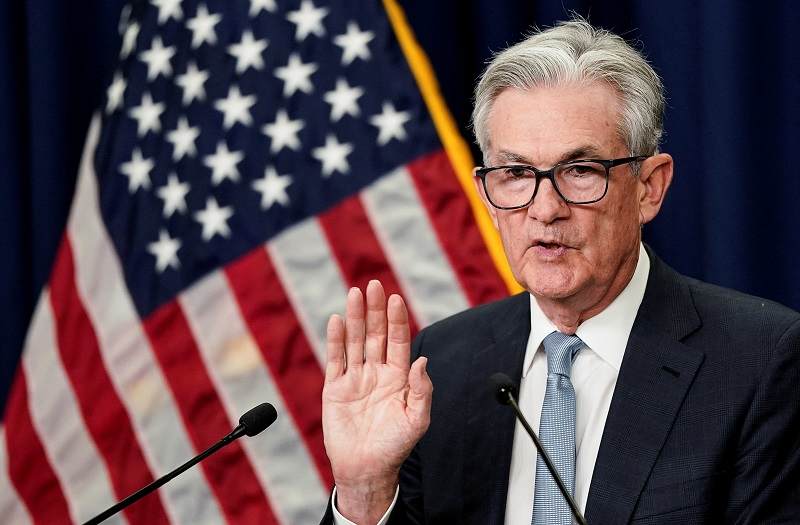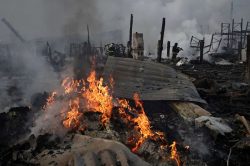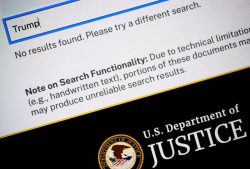
U.S. Federal Reserve Board Chairman Jerome Powell takes questions from reporters after the Federal Reserve raised its target interest rate by three-quarters of a percentage point to stem a disruptive surge in inflation, during a news conference following a two-day meeting of the Federal Open Market Committee (FOMC) in Washington, U.S., June 15, 2022.
9:31 JST, June 16, 2022
WASHINGTON (Reuters) – The Federal Reserve on Wednesday approved its largest interest rate increase in more than a quarter of a century to stem a surge in inflation that U.S. central bank officials acknowledged may be eroding public trust in their power, and being driven by events seen increasingly out of their hands.
The widely expected move raised the target federal funds rate by three-quarters of a percentage point to a range of between 1.5% and 1.75%, still comparatively low by historic standards.
But the Fed’s hawkish commitment to controlling inflation has already touched off a broad tightening of credit conditions being felt in U.S. housing and stock markets, and likely to slow demand throughout the economy – the Fed’s intent.
Officials also envision steady rate increases through the rest of this year, perhaps including additional 75-basis-point hikes, with a federal funds rate at 3.4% at year’s end. That would be the highest level since January 2008 and enough, Fed projections show, to slow the economy markedly in coming months and lead to a rise in unemployment.
“We don’t seek to put people out of work,” Fed Chair Jerome Powell said at a news conference after the end of the Fed’s latest two-day policy meeting, adding that the central bank was “not trying to induce a recession.”
Yet the Fed chief’s remarks were among his most sobering yet about the challenge he and his fellow policymakers face in lowering inflation from its current 40-year high, to a level closer to its 2% target, without a sharp slowdown in economic growth or a steep rise in unemployment.
“Our objective really is to bring inflation down to 2% while the labor market remains strong … What’s becoming more clear is that many factors that we don’t control are going to play a very significant role in deciding whether that’s possible or not” Powell said, citing the war in Ukraine and global supply concerns.
“There is a path for us to get there … It is not getting easier. It is getting more challenging,” he told reporters, noting that the rate hikes announced last month and in March so far had not only failed to slow inflation, but allowed it to continue accelerating to a level that recent data indicates have begun to influence public attitudes in a way that could make the Fed’s job even harder.
‘Eye-catching’
A survey released on Friday showed consumer inflation expectations jumped sharply in June, a result Powell called “quite eye-catching,” and enough to tilt policymakers towards a larger 75-basis-point hike in hopes of making faster progress on the inflation front and retaining public trust that price increases will slow.
“This is something we need to take seriously,” Powell said of the change in consumer inflation expectations. “We’re absolutely determined to keep them anchored.”
The faster pace of rate hikes outlined by officials on Wednesday more closely aligns monetary policy with the rapid shift that took place this week in financial market views of what it will take to bring price pressures under control.
Bond yields fell after the release of Fed projections on Wednesday that showed economic growth slowing to a below-trend rate of 1.7%, and policymakers expecting to cut interest rates in 2024. Stocks on Wall Street ended the day higher.
Interest rate futures markets also reflected about an 85% probability that the Fed will raise rates by 75 basis points at its next policy meeting in July. For September’s meeting, however, the greater probability – at more than 50% – was for a 50-basis-point increase.
Powell, departing from the firmer guidance he has previously given about future rate increases, made no promises on Wednesday.
Given an unexpected jump in a monthly inflation report on Friday and the jump as well in expectations, “75 basis points seemed like the right thing to do at this meeting, and that’s what we did,” he said.
But he said rate hikes of that size were not likely to “be common,” and that when Fed policymakers gather in July an increase of either half a percentage point or three-quarters of a point would be “most likely.”
Not a ‘Volcker moment’
The tightening of monetary policy was accompanied by a downgrade to the Fed’s economic outlook, with the economy now seen slowing to a below-trend 1.7% rate of growth this year, unemployment rising to 3.7% by the end of this year, and continuing to rise to 4.1% through 2024.
While no Fed policymaker projected an outright recession, the range of economic growth forecasts edged toward zero in 2023 – with an index of Fed opinion showing officials almost unanimous in thinking risks were for growth to be slower, and inflation and unemployment higher, than expected.
Analysts, many of them critical of Fed projections in March that saw inflation easing with modest rate hikes and no increase in the unemployment rate, said the new outlook was more realistic.
“The Fed is willing to let the unemployment rate rise and risk a recession as collateral damage to get inflation back down. This isn’t a Volcker moment for Powell given the magnitude of the hike, but he is like a Mini-Me version of Volcker with this move,” said Brian Jacobsen, senior investment strategist at Allspring Global Investments, referring to former Fed Chair Paul Volcker, whose battle with inflation in the early 1980s involved sharp and unexpected rate increases of as much as four percentage points at a time.
Even with the more aggressive interest rate measures taken on Wednesday, policymakers nevertheless see inflation as measured by the personal consumption expenditures price index at 5.2% through this year and slowing only gradually to 2.2% in 2024.
Inflation has become the most pressing economic issue for the Fed and begun to shape the political landscape as well, with household sentiment worsening amid rising food and gasoline prices.
Kansas City Fed President Esther George was the only policymaker to dissent in Wednesday’s decision, preferring a half-percentage-point rate hike.
"News Services" POPULAR ARTICLE
-

American Playwright Jeremy O. Harris Arrested in Japan on Alleged Drug Smuggling
-

Japan’s Nikkei Stock Average as JGB Yields, Yen Rise on Rate-Hike Bets
-

Japan’s Nikkei Stock Average Licks Wounds after Selloff Sparked by BOJ Hike Bets (UPDATE 1)
-

Japanese Bond Yields Zoom, Stocks Slide as Rate Hike Looms
-

Japan’s Nikkei Stock Average Buoyed by Stable Yen; SoftBank’s Slide Caps Gains (UPDATE 1)
JN ACCESS RANKING
-

Keidanren Chairman Yoshinobu Tsutsui Visits Kashiwazaki-Kariwa Nuclear Power Plant; Inspects New Emergency Safety System
-

Imports of Rare Earths from China Facing Delays, May Be Caused by Deterioration of Japan-China Relations
-

University of Tokyo Professor Discusses Japanese Economic Security in Interview Ahead of Forum
-

Japan Pulls out of Vietnam Nuclear Project, Complicating Hanoi’s Power Plans
-

Govt Aims to Expand NISA Program Lineup, Abolish Age Restriction

























